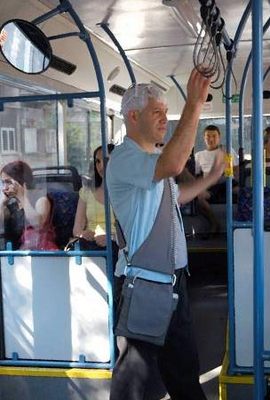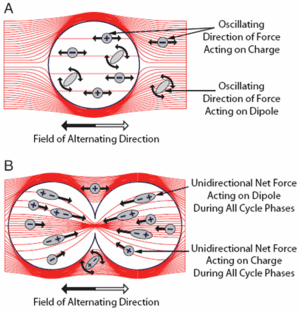An Israeli company is conducting human tests for a device that uses weak electric fields to kill
cancer cells but has no effect on normal cells. The device is in late-stage clinical trials in the United States and Europe for glioblastoma, a deadly brain cancer. It is also being tested in Europe for its effectiveness against breast cancer. In the lab and in animal testing, treatment with electric fields has killed cancer cells of every type tested.

|
| ©MIT
|
| A patient in a clinical trial for a device that generates a weak electric field intended to eradicate brain tumors must wear the device almost constantly but can continue normal activities such as riding the bus. The device fits in a small briefcase, and the patient wears disposable adhesive electrodes on his or her scalp.
|
The electric-field therapy was developed by
Yoram Palti, a physiologist at the Technion-Israel Institute of Technology, in Haifa, who founded the company
NovoCure to commercialize the treatment. Palti's electric fields cause dividing cancer cells to explode while having no significant impact on normal tissues. The range of electric fields generated by the device harms only dividing cells. And since normal cells divide at a much slower rate than cancer cells, the electric fields target cancer cells. "An Achilles' heel of cancer cells is that they have to divide," says
Herbert Engelhard, chief of neuro-oncology in the department of neurosurgery at the University of Illinois, Chicago.

|
| ©Proceedings of the National Academy of Sciences
|
| The weak electric field generated by the NovoCure device, represented by red lines, passes through normal cells without harming them (top), causing some gentle oscillations of charged molecules (gray circles and ovals) inside the cell. In a dividing cell (below), the electric field concentrates at the center, where one cell is pinching in half. Molecules like DNA are pulled toward this concentrated point and torn up.
|
Even after chemotherapy, radiation therapy, and surgery, about 85 to 90 percent of glioblastoma patients' cancer still progresses, and their survival rates are low, says Engelhard. He has about 10 glioblastoma patients enrolled in the trial, which is testing the unusual treatment in patients for whom all other approaches have failed. Engelhard says that the results are encouraging but that it's too early to comment on the treatment's efficacy.
The electric fields' different effects on normal and dividing cells mostly have to do with geometry. A dividing cell has what Palti calls "an hourglass shape rather than a round shape." The electric field generated by the NovoCure device passes around and through round cells in a uniform fashion. But the narrow neck that pinches in at the center of a dividing cell acts like a lens, concentrating the electric field at this point. This non-uniform electric field wreaks havoc on dividing cells. The electric field tears apart important biological molecules, such as DNA and the structural proteins that pull the chromosomes into place during cell division. Dividing cells simply "disintegrate," says Palti.
Palti, who for years has been studying the effect of electric fields on cancer and normal cells, says that he has verified this mechanism in computer models and experiments in the lab. "The physics are solid," says
David Cohen, associate professor of radiology at Harvard Medical School.
Patients in the glioblastoma clinical trial wear the device almost constantly, carrying necessary components in a briefcase. A wire emerging from the briefcase connects to adhesive electrodes covering the skull. Alternating electric fields pass through the scalp, into the skull, and on to the brain. The Food and Drug Administration approved the device for late-stage clinical trials for glioblastoma following promising results from a pilot study in 10 patients, one of whom had a complete recovery.
Reader Comments
to our Newsletter